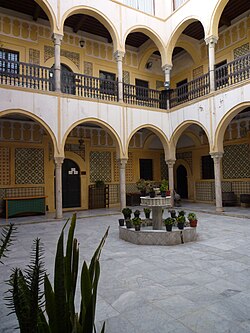Turks in Libya
The Turks in Libya, also commonly referred to as Kouloughlis (Arabic: كراغلة) are Libyans who claim partial descent from Ottoman Janissaries in Libya. Quantifiying their presence/population in Libya in the modern day is near impossible, due to them assimilating near entirely in the Libyan population over time. They mainly make up a small fraction of the populations of the cities, Misrata and Tripoli.
During Ottoman Alleigance/Alliance in Libya (1551–1912), Turkish Janissaries began to migrate to the region. A minimal number of said Turks, and Janissaries intermarried with the native population, and their offspring were referred to as Kouloughlis (Turkish: kuloğlu) due to their mixed heritage.
After the disintegration of the Ottoman Empire, Turks continued to migrate to Libya from the newly established modern states. However, contrary to popular belief, the large majority of said migrants were Cretan Muslims, who were often referred to as Turks by some Christian Greeks due to their religion; not their ethnic background.[citation needed]
History
Ottoman Libya


During Ottoman Alleigance/Alliance in Libya (1551–1912), Turkish Janissaries began to migrate to the region. A minimal number of said Turks, and Janissaries intermarried with the native population, and their offspring were referred to as Kouloughlis (Turkish: kuloğlu) due to their mixed heritage.
Today there are no Libyans who record their ethnicity as Turkish, or acknowledge their descent from the Ottomans.
Italian Libya
After Libya fell to the Italians in 1911, most Kouloughlis still remained in the region, They played no role in the Resistance itself, and remained an idle, subservient, minority of the population.
Culture
As a result of four centuries of Ottoman Presence/Alliance to and within Libya, the Libyans left some of their cultural imprints on the Turks, particularly their language, food, and costumes, which the Kouloughlis adopted from the locals.[citation needed]
Religion
The Ottoman brought with them the teaching of the Hanafi School of Islam during the Ottoman, However the large majority of the Sunni Muslim Libyan population follows the Maliki school of thought.
Notable people
- Salah Badi, commander of the Al-Somood Front
- Emrullah Barkan, politician
- Husni Bey, business tycoon
- Wissam Bin Hamid, commander in the Libya Dawn
- Mukhtar al-Jahawi, commander of the Anti-Terrorism Force
- Abdul Rauf Kara, leader of the Special Deterrence Force
- Ahmed Karamanli, founded the Karamanli dynasty (1711–1835)
- successors:
- Ahmed I (29 July 1711 – 4 November 1745)
- Mehmed Pasha (4 November 1745 – 24 July 1754)
- Ali I Pasha (24 July 1754 – 30 July 1793)
- Ali Burghul Pasha Cezayrli (30 July 1793 – 20 January 1795)
- Ahmed II (20 January – 11 June 1795)
- Yusuf Karamanli (11 June 1795 – 20 August 1832)
- Mehmed Karamanli (1817, 1826, and 1832)
- Mehmed ibn Ali (1824 and 1835)
- Ali II Karamanli (20 August 1832 – 26 May 1835)
- Faruk Kenç, film director and producer
- Sadullah Koloğlu, former prime minister of Benghazi and Darnah (from 1949 to 1952)
- Cenap Muhittin Kozanoğlu, writer
- Suat Kuyaş, soldier
- Omar Abdullah Meheishy, former Member of the Libyan Revolutionary Command Council
- Muhammad Sakizli, Libyan politician
- Galip Kemali Söylemezoğlu, diplomat and ambassador to Greece
- Ramadan al-Suwayhili, a co-founder of the short-lived Tripolitanian Republic in 1918
- Rasim Ferit Talay, politician
- Sadettin Ferit Talay, politician
- İlhami Bekir Tez, writer
- Muzaffer Tuğsavul, soldier
- Hamida al-Unayzi, champion of women's education in Libya
See also
- Libya–Turkey relations
- Turkish minorities in the former Ottoman Empire
- Foreign relations of Libya
- History of Libya